Decoding Generative Art
Julia Kaganskiy, curator of Infinite Images: The Art of Algorithms
Since the dawn of the modern computing era in the mid-twentieth century, artists have worked alongside engineers (and, in fact, often as engineers themselves) to investigate the potential of computational tools and their impact on creativity, culture, and the human experience writ large. At the heart of this pursuit has been a sustained study and engagement with algorithms, generative systems, and automation as both the materials and animating forces that have come to define not just the art of this era, but the cybernetic logic and values that have embedded themselves so deeply into how society understands itself.
Today, in 2025, our world is profoundly shaped by algorithmic decision-making and, increasingly, by media generated with artificial intelligence (AI). From our social media feeds to the workplace, from the doctor’s office to the supermarket, there are few areas of our daily lives that remain untouched by algorithmic systems and automation. While this may feel like a new phenomenon of the digital age, the trajectories that set these developments in motion follow a long arc that extends at least as far back as the Industrial Revolution. Despite the impact of these systems on our lives and livelihoods, for many of us they still feel foreign and obscure. They’re hidden beneath the sleek frictionless design of software and apps, masked by technical know-how and expertise, and often simply inaccessible due to proprietary corporate policies. While the complexity of our rapidly evolving digital environment can be hard to parse even for the most tech savvy among us, a rudimentary understanding of algorithms, generative systems, and automation can provide some firm ground on which to orient oneself amid the shifting tides of change.
Against this backdrop, the exhibition Infinite Images: The Art of Algorithms examines how artists working with generative systems, both analog and digital, have historically negotiated chance and control, emergence and intention, and authorship with automation. Many defining aspects of the so-called “generative art” that is the subject of this exhibition are not inherently novel or even inherently digital, yet they offer much in the way of deepening our understanding and appreciation of how humans design and deploy systems, and how these systems then take on a productive power of their own. Through an in-depth and expansive consideration of how artists work with generative processes, the exhibition sheds light on contemporary questions regarding authorship, creativity, and the role of human agency in an increasingly automated world.
What is Generative Art?
“Generative art” can be tricky to define because it describes a process or technique that can be applied in many different ways. It has also evolved over time with the development of new technologies such as blockchain and AI. Broadly speaking, generative art is art that is created, in whole or in part, using an autonomous system. This autonomous system could be another person or group of people carrying out a set of instructions, a computer executing an algorithmic program, or even a chemical or biological process, such as a work that is grown rather than fabricated. In generative art, the artist designs the plan that will create the work. Each plan contains within it a range of possibilities—some encompassing a finite number of variations, some infinite. What the artist creates is a system that can operate independently and unfold in ways that yield many different results, including ones that the artist never even imagined or predicted. This element of surprise and discovery is part of what makes generative art an exciting and compelling method for many artists. It allows them to reach beyond the limitations of their own taste, biases, or learned conventions to arrive at previously unthought-of creative ideas that, in turn, add to and expand their visual and conceptual vocabulary.
This essay explores some of the defining characteristics of generative art that apply across a range of media, from the analog to the digital.
Algorithms
At the heart of a generative artwork is an algorithm that outlines the step-by-step instructions defining the work and its fundamental structure. We can think of an algorithm as analogous to a recipe or a musical score—it may be originally composed by one person and executed by another, leaving room for interpretation and variation.
The algorithm itself was invented in the ninth century by a Persian mathematician named Muhammad ibn Musa al-Khwarizmi, known as the “Father of Algebra”. Al-Khwarizmi devised the algorithm as a logical, structured method for problem-solving. His contribution became a foundational principle that would go on to profoundly shape science, technology, and art. It is probably no coincidence, therefore, that many scholars cite Islamic girih tile mosaics as one of the earliest examples of generative art. The geometric girih design represents a toolkit for generating large numbers of distinctive and complex tessellated patterns formed from a set of five equilateral polygon shapes—pentagons, decagons, rhombi, bowties, and irregular hexagons. This pre-defined set of geometric patterns has been used by artisans since the late twelfth century to design the intricate strapwork decoration commonly found in Islamic architecture.
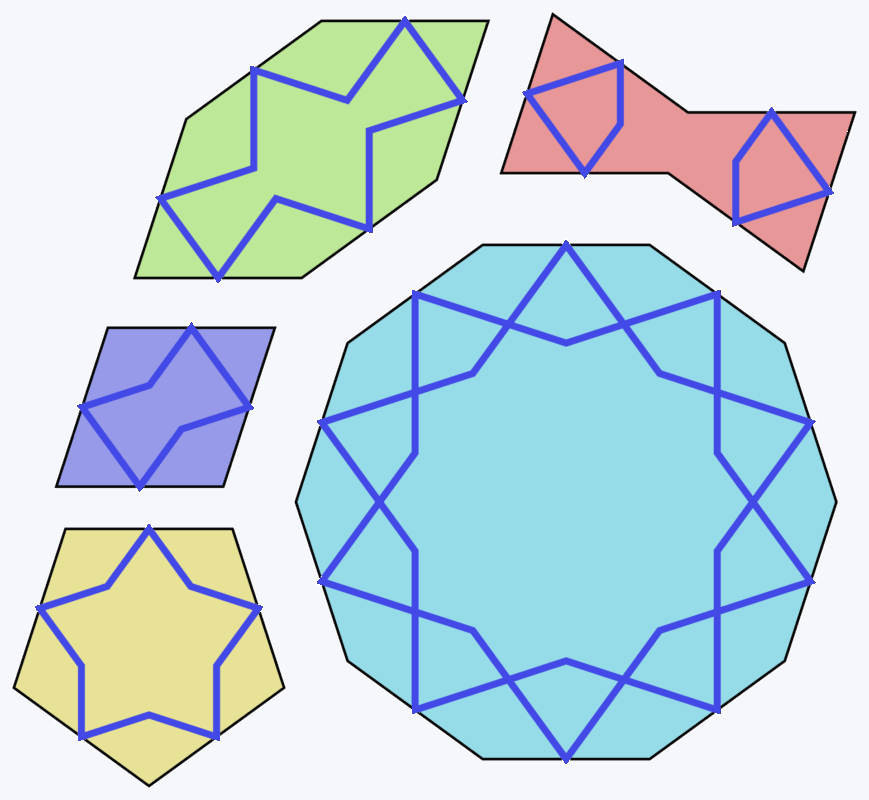
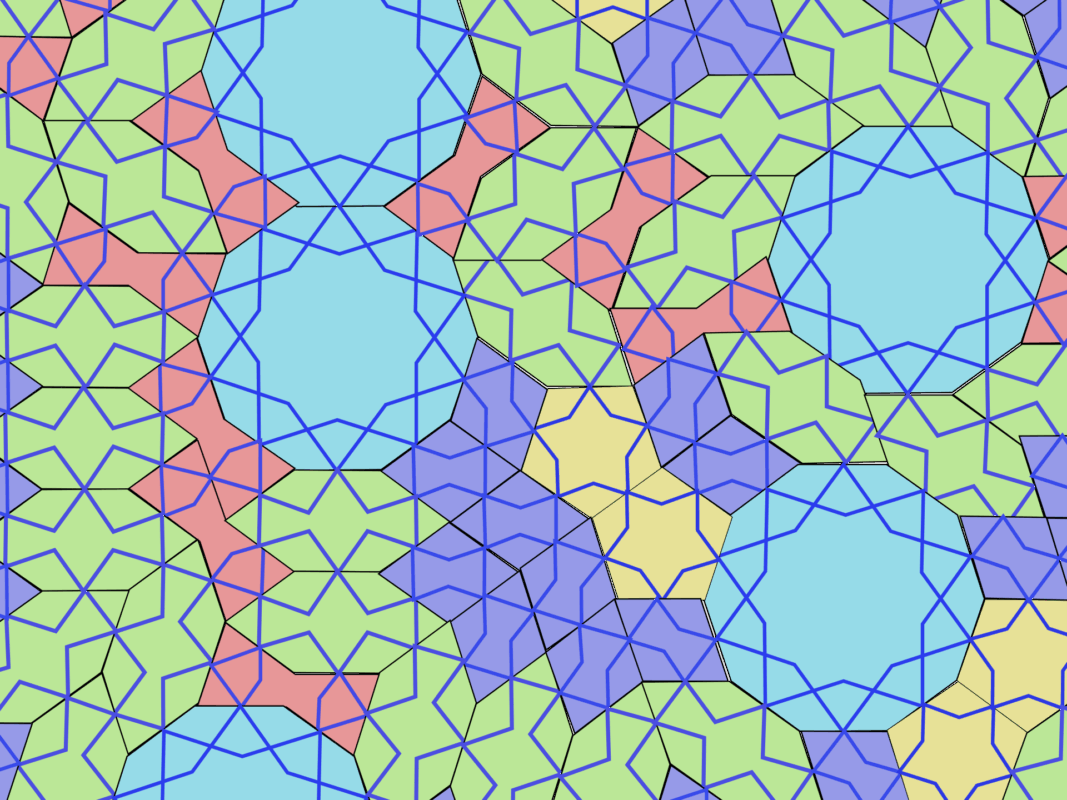
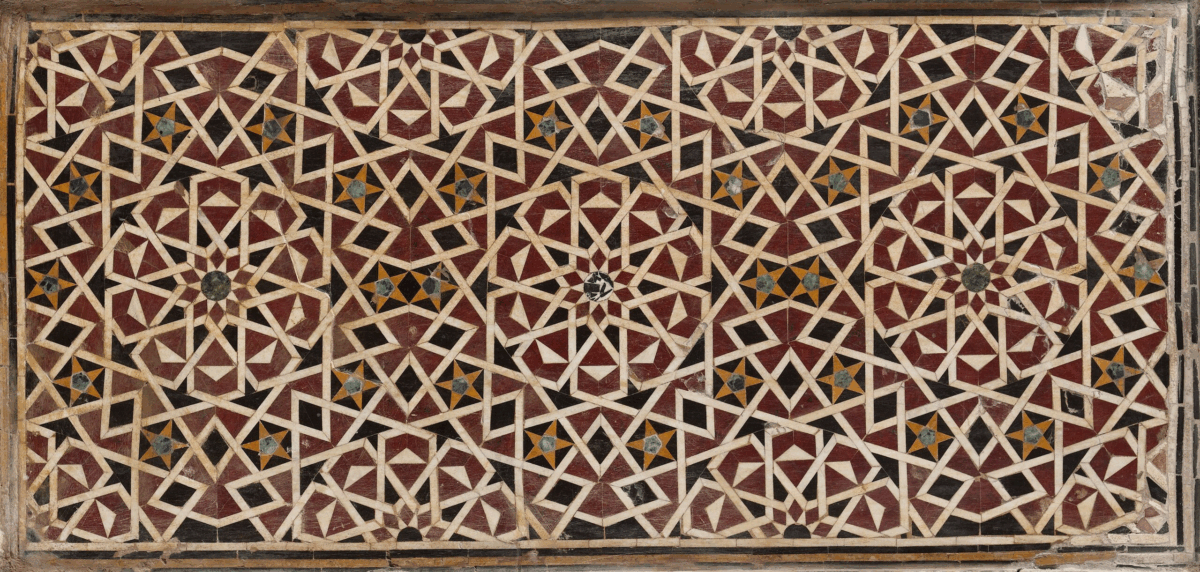
The use of mathematic principles in art did not start with the algorithm and has an even longer history, dating back at least to ancient Greece. Artists have long embedded calculation, such as of proportions or perspective, into their work. However, in the twentieth century, mathematics became the method and subject of artistic experimentation for the first time. Artists began exploring how simple geometric shapes and mathematic principles could form the basis for a new theory of aesthetics. Influenced by developments in science, industry, technology, and radical egalitarian politics that sought to create a more democratic art, many of the avant-garde movements of the early twentieth century—including Russian Constructivism, German Bauhaus, Dutch De Stijl, and Concrete art —celebrated logic, order, and a rational, “objective” approach to art and design rooted in mathematics and rule-based systems.
Some artists, such as Vera Molnár and Max Bill (both featured in Infinite Images), went so far as to pursue a scientifically informed theory of aesthetics founded on mathematics and the study of perception. This stemmed from a rejection of the Romantic notion of singular “artistic genius,” in the pursuit of a more rational, universal approach to artmaking and appreciation. Molnár employed an experimental, trial-and-error method in her work, which allowed her to systematically alter one element at a time and then evaluate its impact on the overall composition. She used this method whether working by hand or with a computer, an algorithmic process that followed a simple step-by-step procedure but could generate a whole universe of possibilities.
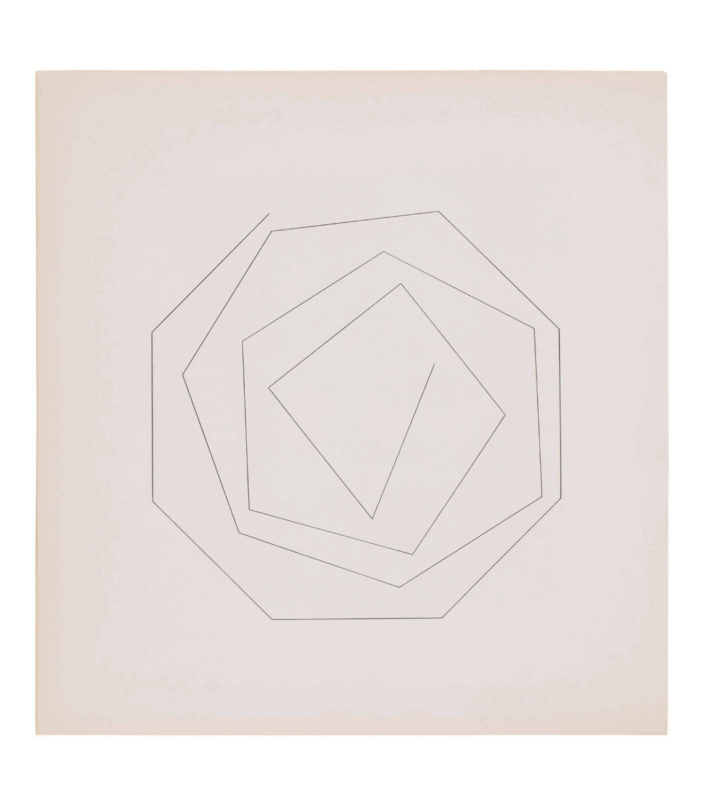
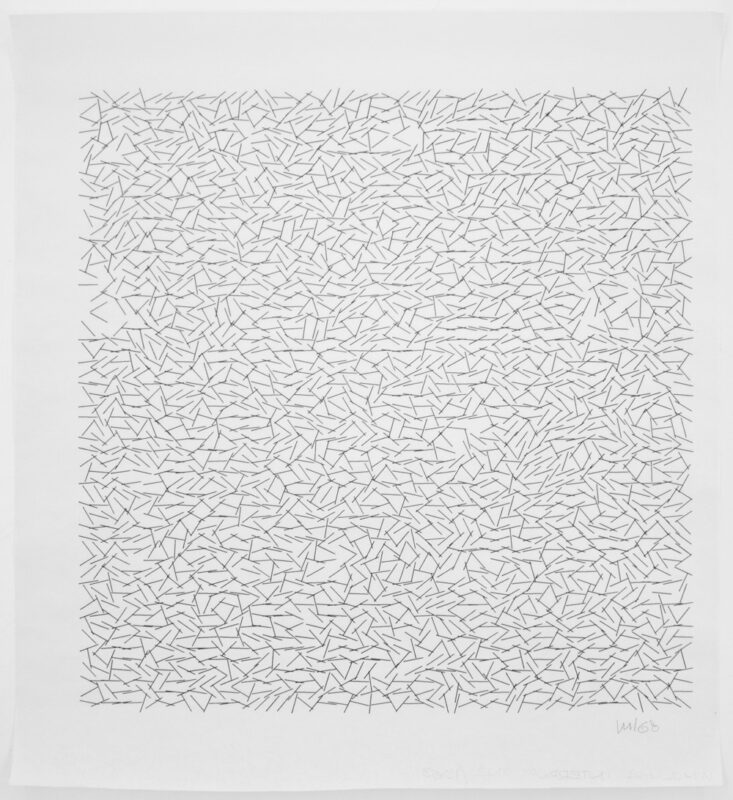
Generative Systems
We can also think of algorithms as describing generative systems—a set of rules that outlines how different elements interrelate and interact to form a unified, complex whole. One of the ways in which generative art constitutes a radical departure from traditional painting or sculpture is that it is more concerned with process than product. In generative art, the artist creates a system, a sequence of operations that unfold over time to produce something new. The essence of the creative act—where the artist makes decisions and expresses their intent—lies in the design of the system rather than any singular output.
In the years following the Second World War, artists began engaging with systems formally and conceptually, influenced by theories emerging from biology, mathematics, and computation.
New ideas were forged and formalized in war-time military industrial research centers, including Norbert Weiner’s theory of cybernetics, which describes how feedback loops shape the evolution of biological and technological systems. Such ideas permeated thinking across ecology, economics, psychology, social science, engineering, and beyond. Curator and art critic Jack Burnham noted the profound influence of systems thinking on contemporary artistic practice—from happenings to Conceptual art to computer-generated art—in a 1968 essay in Artforum titled “Systems Esthetics.” “We are now in transition from an object-oriented to a systems-oriented culture,” he wrote. “Here change emanates, not from things, but from the way things are done.”
The same year Burnham wrote his essay the landmark exhibition Cybernetic Serendipity, curated by Jasia Reichardt, opened. Held at the Institute of Contemporary Art in London, the exhibition reflected the growing influence of computation on culture, assembling recent developments in art, music, and technology. It can be considered the first comprehensive international survey of generative art. Works in the show were often the result of collaborations between artists and scientists in a radically interdisciplinary approach. They spanned a wide range of media including computer-generated drawings by artists like Vera Molnár, Frieder Nake, and Charles Csuri, robotic sculptures by Nam June Paik, Jean Tinguely, and Edward Ihnatowicz, computer-generated music by John Cage, Iannis Xenakis, and Peter Zinovieff, as well as computer-generated poetry, dance, and more.
However, as previously mentioned, generative systems need not necessarily be computational. We can look at the cybernetics-inspired work of a conceptual artist like Hans Haacke whose 1963 sculpture Condensation Cube is effectively a miniature model of an environmental system in action. To create this work, Haacke placed a small amount of water inside a transparent acrylic cube and sealed it, forming a closed system where the cycle of evaporation and condensation unfolds endlessly in response to changes in temperature. The condensed vapor and rivulets of water running down the sides of the cube create an ever-changing chaotic pattern that the artist can neither predict nor control. As Haacke himself explained: “The conditions are comparable to a living organism which reacts in a flexible manner to its surroundings. The image of condensation cannot be precisely predicted. It is changing freely, bound only by statistical limits. I like this freedom.”

Automation
Not all artworks that utilize rule-based systems can be truly considered generative. Key to the definition of generative art is the role of automation in which the artist cedes some amount of control to an autonomous process. This relinquishing of control introduces elements of chance and randomness that allow for complexity to emerge from within even a simple rule set. For example, Josef Albers’ Homage to the Square series uses a clear rule-based system of concentric squares where the artist varies color combinations. But the work is not truly generative because the artist is still responsible for every decision, even when using a mechanical process such as screen printing, as in the Soft Edge—Hard Edge series showcased in Infinite Images. By contrast, Sol LeWitt’s wall drawing instructions, which were typically executed not by LeWitt but by assistants and installers, could be considered generative because the process of their execution is automatic and occurs independently of the artist.
Though we tend to associate automation with computers and, increasingly, with artificial intelligence, the modern definition of automation (i.e. a process that does not require human involvement) has its roots in the Industrial Revolution. A prominent example is the Jacquard mechanized loom, first introduced in 1805. One of the first machines to be programmed, the Jacquard allowed for complex textile patterns to be generatively produced using punched cards that could store the information needed to create each pattern. This method of punch card programming was later adapted by Charles Babbage in the invention of the computer and was still in use well into the 1960s when the earliest computer artists were making their first computer-generated drawings.
Likewise, computer artists are far from the first to employ aspects of automatism in artmaking. Many artists have turned to chance procedures and randomness as a means of bypassing the artist’s subjectivity in service of various ideological and conceptual ends — from the Dadaist engagement with the absurd to the Surrealist search for the unconscious. However, the computer offers the distinct advantage of being able to enact a precise system and randomness at the same time, striking a balance between order and chaos, chance and control. The computer’s random number generator function allows the machine to make arbitrary and unpredictable selections without subjective involvement. “Randomness is a great artist,” said Vera Molnár. “We’re constantly repeating ourselves, but randomness is always coming up with something new.”
Today’s machine learning AI tools introduce another layer of automation. Artists working with algorithmic generative processes would have to program every aspect of the work by hand—outlining all the logic and parameters that define the possibility space of the work, such as its color palette, its form, structure, motion, and other qualities. These elements could then be combined in dozens, hundreds, or thousands of different permutations to generate a potentially infinite number of variations that all correspond to a particular visual system or concept. With machine learning tools, a key difference in this process is that the programming of the algorithmic model is not done by a human author but is also automated—the machine effectively trains itself. Instead of the artist or programmer prescribing the instructions that must be carried out, the machine learning model “learns” the rules by studying training data such as images, text, video, or music. From the given data set, the model will extract and categorize patterns and relationships, then use this information to create new content based on what it has learned. The result is a generative system that still operates algorithmically and combinatorially, but often according to an inferred machine logic that, while effective, is not readily legible to its human creators.
The level of automation we see in machine learning-based generative AI like Open AI’s ChatGPT, Anthropic’s Claude, and Google’s Gemini is far more complex and abstracted from any original “author” than the punched cards of the Jacquard loom or the rudimentary algorithmic programs of early computer artists. These generative AI tools are capable of learning, reasoning, interpreting, and generating content with far less human input or intervention than the rule-based autonomous systems that came before. Nevertheless, becoming familiar with the operations of simpler generative systems can provide a useful level of insight into the underlying processes that become obscured through these more complex higher-order models. These tools are not magic. They are the product of human ingenuity and labor rendered as algorithms, code, silicon, and data. The text, images, video, and music they produce are not so much invented by intelligent machines as uncovered through the extraction of patterns in the data that are then combined into new arrangements. In a way, the process is not so different from the girih tiles, except that now there are trillions of puzzle pieces that can be combined rather than five.
Conclusion
The trajectory from al-Khwarizmi’s 9th-century algorithms to today’s machine learning systems reveals a continuous thread of human fascination with creating systems that can generate complexity from simplicity. Whether expressed through simple rule-based algorithms or the neural networks that power contemporary AI art, generative processes have consistently offered artists a means to transcend individual limitations and discover unexpected creative possibilities.
What unites these diverse practices across centuries is not their technology, but their shared exploration of a fundamental question: how can systematic processes extend human creativity? From Sol LeWitt’s instruction-based wall drawings to today’s AI-generated imagery, artists have repeatedly found that relinquishing control can paradoxically expand creative agency. By designing systems rather than objects and establishing rules rather than predetermined outcomes, they create frameworks for emergence—spaces where the planned and the unforeseen can coexist.
As we navigate an increasingly automated world, generative art offers more than just pretty pictures. It provides a lens for understanding how human intention and automation can work together productively. These artworks demonstrate that the relationship between creator and system need not be adversarial or zero-sum but can instead be collaborative and expansive. In studying how artists have historically negotiated questions of authorship, control, and emergence, we gain valuable insights into our contemporary moment—one where the ability to work meaningfully with autonomous systems may well define the future of human creativity itself.
A step-by-step set of instructions or rules for solving a problem or completing a task. A recipe is an algorithm, as is a computer program.
A subfield of artificial intelligence that uses generative models trained on large data sets to create new content—text, images, music, or videos—by mimicking the underlying structures, patterns, and styles of what it was trained on. Popular commercial generative AI tools like ChatGPT, Dall-E, and Midjourney use a chatbot feature where users can prompt the AI system using natural language rather than code. These large-scale systems are trained using trillions of data points collected from the internet and are controversial for the way they appropriate (and imitate) existing intellectual property and for their energy usage and environmental impact.
A state in which machines or computer programs perform tasks that humans once did manually with minimal or no human intervention.
The ability of a computer to simulate human intelligence by performing tasks such as learning, reasoning, problem-solving, and understanding language. AI systems can analyze data, recognize patterns, make predictions, and adapt their behavior based on experience.
A digital ledger that stores information across many computers instead of one central location. Each new record links to previous ones, forming a secure chain of “blocks” (packages of encrypted data) that is extremely difficult to alter or hack. Blockchain technology has been used to create cryptocurrencies and non-fungible tokens (NFTs) due to its ability to securely record transactions without requiring the authentication of a centralized regulatory body.
First used in 1948 by Norbert Wiener to describe self-regulating entities (such as the brain), cybernetics refers to the study of the feedback loop, or a closed system where the output becomes the next input, which shapes future operations of the system.
An approach to parsing out the world’s complexities that emphasizes the interconnectedness of the “whole,” as well as the relationships—rather than the distinctions—among its parts. Biologist Ludwig Von Bertalanffy originated General Systems Theory (GST) in 1937, in part to describe how the behavior of a system varies when changes are made to one or several of its components.
A system that produces unpredictable sequences of numbers. Computers use mathematical algorithms (pseudorandom) or physical processes (true random) to generate these numbers, which are essential for encryption, simulations, games, and creating variety in digital art and other applications.
A branch of artificial intelligence in which computers learn to make predictions or decisions by finding patterns in data, rather than being explicitly programmed for each task. The system improves its performance automatically through experience or the input of new data, getting better at tasks like recognizing images, translating languages, or making recommendations.
Relating to the combination of elements from a numerical set, arranged in no particular order.
A type of learning algorithm associated with machine learning and artificial intelligence that is modeled and structured on how the human brain works. It uses interconnected nodes (like brain neurons) to process information, recognize patterns, and learn from data. By adjusting connections between nodes, it can improve at tasks like image recognition or language processing.
When simple elements interact to create complex behaviors or patterns that could not be predicted from the individual components alone. It’s how ant colonies organize without a leader, how consciousness arises from neurons, or how water molecules create waves: Something new emerges from simpler parts interacting.